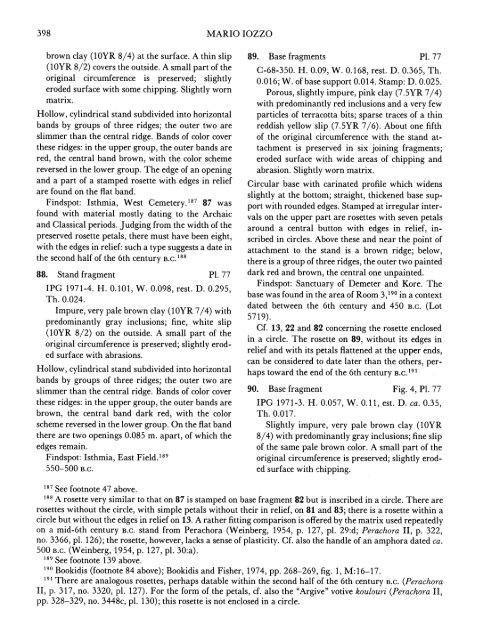f - The American School of Classical Studies at Athens
f - The American School of Classical Studies at Athens
f - The American School of Classical Studies at Athens
You also want an ePaper? Increase the reach of your titles
YUMPU automatically turns print PDFs into web optimized ePapers that Google loves.
398 MARIO IOZZO<br />
brown clay (1OYR 8/4) <strong>at</strong> the surface. A thin slip<br />
(1OYR 8/2) covers the outside. A small part <strong>of</strong> the<br />
original circumference is preserved; slightly<br />
eroded surface with some chipping. Slightly worn<br />
m<strong>at</strong>rix.<br />
Hollow, cylindrical stand subdivided into horizontal<br />
bands by groups <strong>of</strong> three ridges; the outer two are<br />
slimmer than the central ridge. Bands <strong>of</strong> color cover<br />
these ridges: in the upper group, the outer bands are<br />
red, the central band brown, with the color scheme<br />
reversed in the lower group. <strong>The</strong> edge <strong>of</strong> an opening<br />
and a part <strong>of</strong> a stamped rosette with edges in relief<br />
are found on the fl<strong>at</strong> band.<br />
Findspot: Isthmia, West Cemetery.'87 87 was<br />
found with m<strong>at</strong>erial mostly d<strong>at</strong>ing to the Archaic<br />
and <strong>Classical</strong> periods. Judging from the width <strong>of</strong> the<br />
preserved rosette petals, there must have been eight,<br />
with the edges in relief: such a type suggests a d<strong>at</strong>e in<br />
the second half <strong>of</strong> the 6th century B.C."88<br />
88. Stand fragment P1. 77<br />
IPG 1971-4. H. 0.101, W. 0.098, rest. D. 0.295,<br />
Th. 0.024.<br />
Impure, very pale brown clay (1OYR 7/4) with<br />
predominantly gray inclusions; fine, white slip<br />
(1OYR 8/2) on the outside. A small part <strong>of</strong> the<br />
original circumference is preserved; slightly eroded<br />
surface with abrasions.<br />
Hollow, cylindrical stand subdivided into horizontal<br />
bands by groups <strong>of</strong> three ridges; the outer two are<br />
slimmer than the central ridge. Bands <strong>of</strong> color cover<br />
these ridges: in the upper group, the outer bands are<br />
brown, the central band dark red, with the color<br />
scheme reversed in the lower group. On the fl<strong>at</strong> band<br />
there are two openings 0.085 m. apart, <strong>of</strong> which the<br />
edges remain.<br />
Findspot: Isthmia, East Field.189<br />
550-500 B.C.<br />
89. Base fragments P1. 77<br />
C-68-350. H. 0.09, W. 0.168, rest. D. 0.365, Th.<br />
0.016; W. <strong>of</strong> base support 0.014. Stamp: D. 0.025.<br />
Porous, slightly impure, pink clay (7.5YR 7/4)<br />
with predominantly red inclusions and a very few<br />
particles <strong>of</strong> terracotta bits; sparse traces <strong>of</strong> a thin<br />
reddish yellow slip (7.5YR 7/6). About one fifth<br />
<strong>of</strong> the original circumference with the stand <strong>at</strong>-<br />
tachment is preserved in six joining fragments;<br />
eroded surface with wide areas <strong>of</strong> chipping and<br />
abrasion. Slightly worn m<strong>at</strong>rix.<br />
Circular base with carin<strong>at</strong>ed pr<strong>of</strong>ile which widens<br />
slightly <strong>at</strong> the bottom; straight, thickened base sup-<br />
port with rounded edges. Stamped <strong>at</strong> irregular inter-<br />
vals on the upper part are rosettes with seven petals<br />
around a central button with edges in relief, in-<br />
scribed in circles. Above these and near the point <strong>of</strong><br />
<strong>at</strong>tachment to the stand is a brown ridge; below,<br />
there is a group <strong>of</strong> three ridges, the outer two painted<br />
dark red and brown, the central one unpainted.<br />
Findspot: Sanctuary <strong>of</strong> Demeter and Kore. <strong>The</strong><br />
base was found in the area <strong>of</strong> Room 3,190 in a context<br />
d<strong>at</strong>ed between the 6th century and 450 B.C. (Lot<br />
5719).<br />
Cf. 13, 22 and 82 concerning the rosette enclosed<br />
in a circle. <strong>The</strong> rosette on 89, without its edges in<br />
relief and with its petals fl<strong>at</strong>tened <strong>at</strong> the upper ends,<br />
can be considered to d<strong>at</strong>e l<strong>at</strong>er than the others, per-<br />
haps toward the end <strong>of</strong> the 6th century B.C.191<br />
90. Base fragment Fig. 4, P1. 77<br />
IPG 1971-3. H. 0.057, W. 0.11, est. D. ca. 0.35,<br />
Th. 0.017.<br />
Slightly impure, very pale brown clay (1OYR<br />
8/4) with predominantly gray inclusions; fine slip<br />
<strong>of</strong> the same pale brown color. A small part <strong>of</strong> the<br />
original circumference is preserved; slightly eroded<br />
surface with chipping.<br />
187 See footnote 47 above.<br />
188 A rosette very similar to th<strong>at</strong> on 87 is stamped on base fragment 82 but is inscribed in a circle. <strong>The</strong>re are<br />
rosettes without the circle, with simple petals without their in relief, on 81 and 83; there is a rosette within a<br />
circle but without the edges in relief on 13. A r<strong>at</strong>her fitting comparison is <strong>of</strong>fered by the m<strong>at</strong>rix used repe<strong>at</strong>edly<br />
on a mid-6th century B.C. stand from Perachora (Weinberg, 1954, p. 127, pl. 29:d; Perachora II, p. 322,<br />
no. 3366, pl. 126); the rosette, however, lacks a sense <strong>of</strong> plasticity. Cf. also the handle <strong>of</strong> an amphora d<strong>at</strong>ed ca.<br />
500 B.C. (Weinberg, 1954, p. 127, pl. 30:a).<br />
189 See footnote 139 above.<br />
190 Bookidis (footnote 84 above); Bookidis and Fisher, 1974, pp. 268-269, fig. 1, M:16-17.<br />
191 <strong>The</strong>re are analogous rosettes, perhaps d<strong>at</strong>able within the second half <strong>of</strong> the 6th century B.C. (Perachora<br />
II, p. 317, no. 3320, pl. 127). For the form <strong>of</strong> the petals, cf. also the "Argive" votive koulouri (Perachora II,<br />
pp. 328-329, no. 3448c, pl. 130); this rosette is not enclosed in a circle.

















